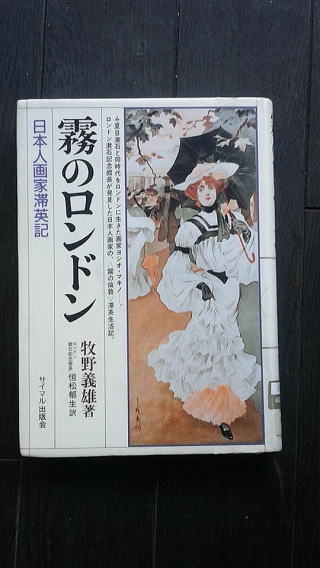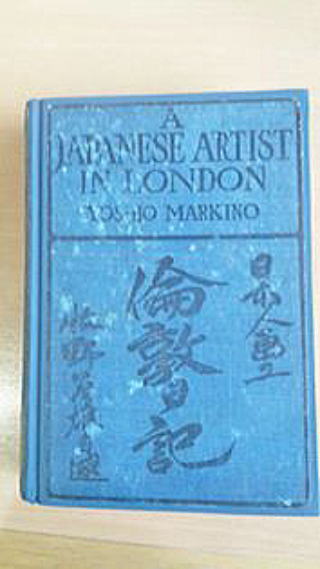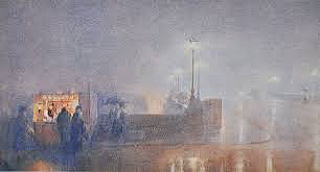| |
牧野義雄 |
Topへ |
| |
画家・牧野義雄を知ったのは、FacebookでのJeny Woolfさんの書き込みだった。「新海誠(1)」参照 |
|
| |
|
|
| |
2016年12月12日
牧野義雄『霧のロンドン』恒松郁生訳 サイマル出版 1991
The original:
A JAPANESE ARTIST IN LONDON
MARKINO, YOSHIO、CHATTO & WINDUS 1910
Dear Jenny Woolf,
I have read a work of Yoshio Markino by its Japanese translation.
I enjoyed his autobiographical facts and his opinions, but could not appreciate his English style which you referred to in Facebook. You wrote there “the books are expressed as a well-educated Japanese person would actually speak, i.e. with a different rhythm and slightly different use of language than an English person, and a conversational tone.”
The translator, Ikuo Tunematsu, is the director of Soseki Museum in London, which was unfortunately closed in September due to one of Brexit effects. |
 |
| |
-
Jenny Woolf Thank you for this post! I am very glad that you found the book interesting.
I wonder if you felt that his approach to life was typical Japanese of
that period (late 19th century). It is quite different from how English
people thought at this time, and so refreshing. I had no idea that it had
been translated into Japanese. I can quite understand that Yoshio Markino's
use of English would be impossible to translate back into Japanese from
the original English. I think that is too hard for any translator, even
one as skilful and dedicated to literature as Mr. Ikuo Tunematsu.
-
宮垣弘 The first and most profound impression which Yoshio Markino had of London was there was little racial prejudice compared to California U.S. where he had lived for four years.
He loved the English people and was loved by them, many of whom supported
him in his poverty. He had courage, sincerity, pride etc., which are common
qualities of the Japanese, especially Samurai.
Soseki Natsume, one of the greatest novelists in Japan, stayed in London during almost the same period as Yoshio. He wrote in his essays that he was frustrated with England and disliked London. While Soseki is Japan’s most famous and favorite writer. Yoshio Markino is almost forgotten as a painter or a writer.
However, compared to Soseki, I like Yoshio’s human nature more.
I found the first (1910) edition of A JAPANESE ARTIST IN LONDON in Tokyo Metropolitan Library.
I would like to write someday about translation.
|
 |
| |
-
Jenny Woolf Thanks for your reply. I think that the circumstances in which Yoshio and
Soseki came to London were very different, so it is not surprising that
their impressions were so diffferent. I don't know what upset Soseki so
much about London but he probably had to contend with the snobbishness
and deep hypocrisy of middle class British society at the time. He sounds
as if his personal life had been rather insecure. Yoshio came from a very
secure background and seemed glad simply to avoid the abuse her suffered
in America, and could therefore build an English life in an optimistic
frame of mind. I like his paintings and I'm glad you found A JAPANESE ARTIST
IN LONDON. I own a copy of the book. I always wonder how Alice can be translated
actually. (I expect you know of Jon Linseth's project about translating
Alice. )
-
宮垣弘 Thanks for your feedback and an information about Jon Linseth.
I guess you are already familiar with Soseki?
I read some articles about Jon Linseth on the web.
As you know, Japan has a lot of Japanese translations of Alice and your friends, Yoshiyuki Monma and Shinichi Kinoshita are great collectors of them.
We enjoy translating Carroll’s word play into Japanese. For example, Alice’s cry “ Curiouser and curouser ! “ is translated into rather strange Japanese.
There are many Japanese versions, because the translations of word play (pun, parody, rhyme, etc.) are difficult, but attractive to translators.
However, translations, such as movies, animes, language translations, are, after all, derivatives of the original. I like Alice best in the original, an English girl living in the Victorian age.
Back to Tsunematsu’s translation.
He translated Markino’s essay into standard Japanese because he thought it was how Markino would have written it in Japanese.
-
Jenny Woolf I am sure that the original of anything is always better. I wish I had the language skills to read in another language than English! I feel sure that Markino would have written in standard Japanese, but I also believe he preferred the English reader
to constantly remember that he was writing from a foreign, indeed a specifically
Japanese, perspective. Naturally, he eschewed the patronising and overdone
dialect which was so popular at the time (cf. many "Punch" cartoons
depicting foreigners). The use of English is charming and the slight "foreignness"
gives me a feeling of life and immediacy.
|
 |
| |
「ちなみにウェイリーと漢詩の妙趣を語りあった最初の東洋人の一人はロンドンで活躍した日本人画家牧野義雄であった。牧野がおっびただひい数の漢詩を(もちろん日本語で)そらんじていたことをウェイリーは彼をしのぶ一文に愛情kめて書いている。
平川祐弘『アーサー・ウェイリー 『源氏物語』の翻訳者』 p70 2020・4・28 |
|
| |
|
|
| |
|
|
| |
|
|
| |
|
|


